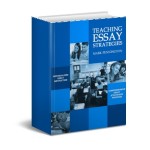How to Grade Writing
How can we effectively assess student writing? Should we grade upon effort, completion, standards, achievement, or improvement? Is our primary task to respond or to grade?
Here’s my take. We should grade based upon how well students have met our instructional objectives. Because each writer is at a different place, we begin at that place and evaluate the degree to which the student has learned and applied that learning, in terms of effort and achievement. But, our primary task is informed response based upon effective assessment. That’s how to grade writing.
For example, here may be an effective procedure for a writing task as it winds its way through the Writing Process:
Diagnostically Assess Writing
1. Diagnostically assess all students’ writing abilities vis a vis a *writing sample that addresses the Common Core State Standard writing task. An on-demand writing task would suffice. Grade on an analytical rubric tied to that content standard and the complementary writing process standards. No holistic rubric-teachers need to isolate the diagnostic variables. Share this data with students and parents. Set goals. Record the scores on a class recording matrix.
*Note: One size does not fit all, so each content standard would necessitate a separate diagnostic assessment.
Pre-teach Writing
2. Select a writing task similar to the diagnostic assessment and teach (whole class) the key writing content and skills necessitated by the writing task. Brainstorming, accessing/building prior knowledge such as with some KWL, anticipation guides, class discussion, or video clips, and modeled pre-writing would make sense. Perhaps some pre-teaching with EL, special needs, SES-disadvantaged students would help.
Differentiate Writing Instruction
3. Plan differentiated instruction in terms of the writing task/expectations for each student by analyzing the data on the class recording matrix. For example, modify the writing prompt, require fewer sentences/body paragraphs, require fewer direct quotes, require fewer citations. Obviously, these modifications will vary according to grade level. Implement differentiated instruction in targeted skill groups based upon the data on the class recording matrix.
4. The students complete their rough draft with concurrent student-teacher mini-conferences a la Writer’s Workshop. Re-teaching via mini-lessons.
Writing Response
5. Upon completion, respond to the rough drafts with specific e-comments. Whether the students are composing on the computer or on paper, it makes sense for the teacher to use cut and paste comments to direct student writing revision. On computers, Microsoft Word bubble comments are great. On paper, printing the comments for each student works well. The Pennington Manual of Style offers a download of 438 writing comments, appropriate for teachers of fourth graders on up. The comments tell students what and why they need to revise with definitions of terms and examples. Save time and do a better job with writing response by using this tool. Grading writing does not have to be the chore that it once was pre-computer age.
writing revision. On computers, Microsoft Word bubble comments are great. On paper, printing the comments for each student works well. The Pennington Manual of Style offers a download of 438 writing comments, appropriate for teachers of fourth graders on up. The comments tell students what and why they need to revise with definitions of terms and examples. Save time and do a better job with writing response by using this tool. Grading writing does not have to be the chore that it once was pre-computer age.
6. The students complete their tasked revisions (per the e-comments) with concurrent student-teacher mini-conferences a la Writer’s Workshop.
7. Either end the writing task after the revision stage or move on to the editing stage to the final draft. Of course, provide culminating publishing opportunities at this unfinished or finished stage. Every writing task does not have to end with a final, polished draft. Teachers do not have to grade each writing component or provide essay response at each stage of the writing process.
Evaluate the Writing
8. Grade the writing revision or final draft as a formative assessment on the same analytical rubric as that of the diagnostic assessment and enter the data on the class recording matrix.
9. Assign the final writing grade (or points) based upon two measures: first, the degree to which the student revised the rough draft according to your e-comment responses (effort); second, the improvement in scores from the diagnostic to the formative assessment (achievement), as indicated on the class recording matrix. Both are certainly quantifiable, for example 9/10 adequate revisions and a net gain of say 8 points from a 48 diagnostic to a 56 formative assessment score. Or why not just give them all A’s? With this kind of instruction, they should all earn top scores.
For those teachers interested in saving time and doing a more thorough job of essay response and grading, check out the The Pennington Manual of Style. This style manual serves as a wonderful writer’s reference guide with all of the writing tips from the author’s comprehensive essay writing curriculum: TEACHING ESSAYS BUNDLE. The style manual (included in the Common Core aligned Teaching Essay Strategies, also includes a download of the 438 writing, grammar, mechanics, and spelling comments teachers use most often in essay response and grading. Placed in the Autocorrects function of Microsoft Word® 2003, 2007, 2010, 2013 (XP, Vista, Windows 7, 8, and 10), teachers can access each comment with a simple mouse click to insert into online student essays or print/e-mail for paper submissions. Each comment identifies the error or writing issue, defines terms, and gives examples so that student writers are empowered to correct/revise on their own. This approach to essay comments produces significantly more accountability and transfer to subsequent writing.

